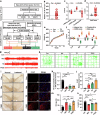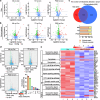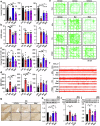Identifying genetic targets in clinical subtypes of Parkinson's disease for optimizing pharmacological treatment strategies
- PMID: 39551798
- PMCID: PMC11570617
- DOI: 10.1038/s41392-024-02020-x
Identifying genetic targets in clinical subtypes of Parkinson's disease for optimizing pharmacological treatment strategies
Abstract
The heterogeneity of Parkinson's disease (PD) has been recognized in clinical, with patients categorized into distinct subsets based on motor phenotype, such as tremor-dominant PD (TD), postural instability and gait difficulty-dominant PD (PIGD) and mixed PD (Mix). Despite this categorization, the underlying mechanisms of this heterogeneity remain poorly understood, and there is no personalized effective treatment for each PD subtype. To address this, a rat model for PD subtypes was established by unilateral stereotaxic injection of 6-OHDA, followed by cluster analysis of behavioral data. The serum neurofilament light chain (NfL) and uric acid (UA) levels as well as alterations in brain autonomic activity in rats were consistent with clinical patients, and metabolomics results showed that more than 70% of the metabolites in the serum of different subtypes of PD rats and clinical patients appeared to be consistently altered. Further transcriptomic analysis by RNA-seq has elucidated that the development of PD subtypes is associated with altered gene expression in neurotransmitter, neuronal damage in the central or peripheral nervous system, and lipid metabolism. In addition, based on the subtype-specific differentially expressed genes, 25 potential drug candidates were identified. Notably, the Alox15 inhibitor baicalein showed a greater efficacy on Mix rats, highlighting the possibility of selecting targeted treatments for well-defined individuals.
© 2024. The Author(s).
Conflict of interest statement
Figures






References
-
- Pang, H. et al. Use of machine learning method on automatic classification of motor subtype of Parkinson’s disease based on multilevel indices of rs-fMRI. Parkinson. Relat. Disord.90, 65–72 (2021). - PubMed
-
- Fereshtehnejad, S.-M. & Postuma, R. B. Subtypes of Parkinson’s disease: what do they tell us about disease progression? Curr. Neurol. Neurosci. Rep.17, 34 (2017). - PubMed
-
- Jankovic, J. et al. Variable expression of Parkinson’s disease: a base-line analysis of the DATATOP cohort. The Parkinson Study Group. Neurology40, 1529–1534 (1990). - PubMed
-
- Thenganatt, M. A. & Jankovic, J. Parkinson disease subtypes. JAMA Neurol.71, 499–504 (2014). - PubMed
Publication types
MeSH terms
Substances
LinkOut - more resources
Full Text Sources
Medical

